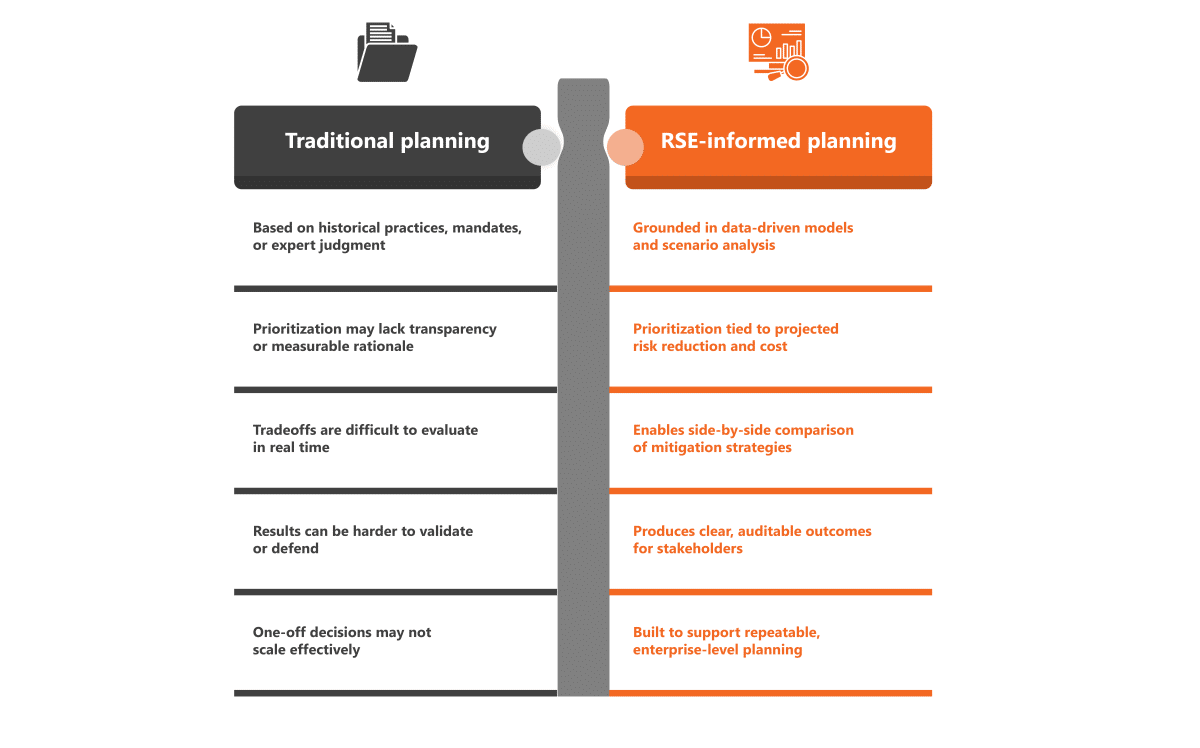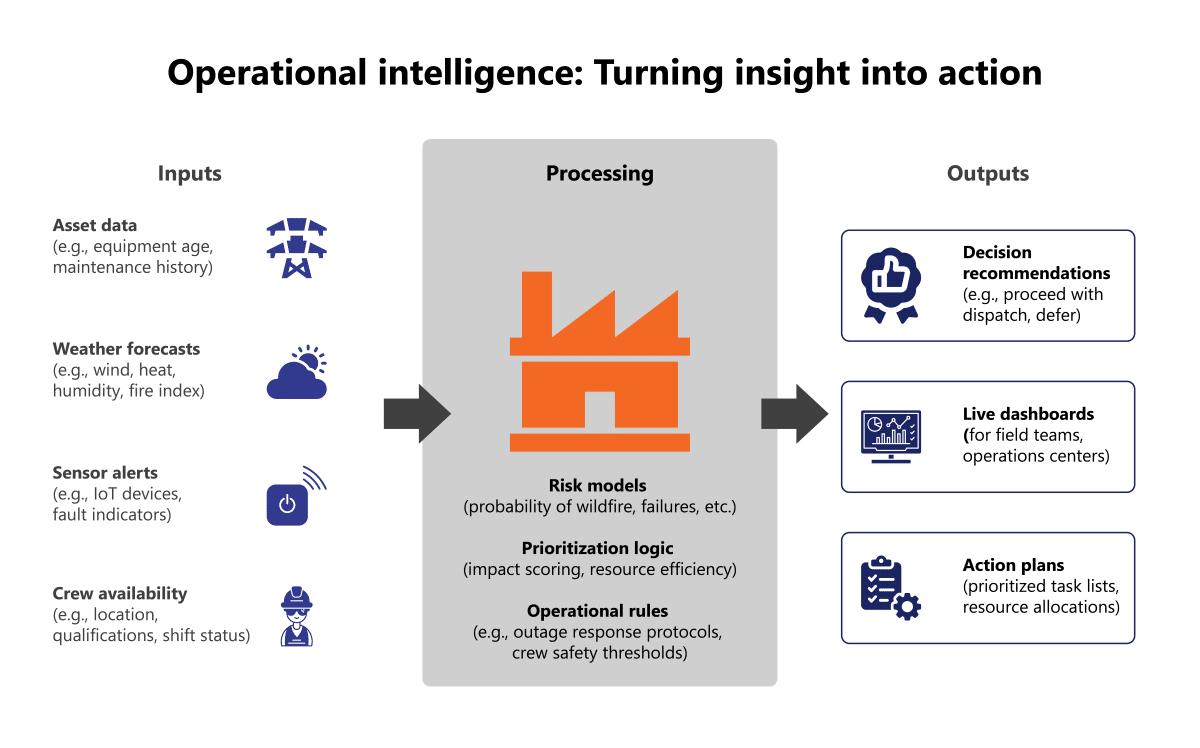5-minute read
Quick summary: How leading utilities are transforming risk management into an enterprise capability by aligning planning with operations, embedding transparency, and scaling what works across programs and geographies
When risk is everywhere—on the ground, in the air, embedded in an aging grid—utilities can’t afford to stay reactive. Enterprise risk management has become a defining capability as leaders face interconnected threats like wildfire exposure, vegetation overgrowth, and asset failure. These risks demand more than compliance checklists or isolated initiatives. They call for a coordinated, data-driven approach that aligns long-term planning with day-to-day operations and drives defensible, high-impact decisions.
Through our work supporting risk mitigation programs at scale, we’ve seen a clear pattern: the most effective utilities treat risk management not as a side task, but as a core operational function. They create integrated frameworks that prioritize impact, support cross-functional coordination, and evolve with new insights. Solutions may take different forms, but they share a common foundation—each is purpose-built, outcome-focused, and crafted to simplify complexity.
In this article, we explore how utilities can operationalize risk mitigation across the full lifecycle—from high-level strategy to frontline execution—using practical, scalable tools and approaches that deliver measurable results.
Article continues below.
WHITE PAPER
Unified risk modeling for utility resilience
Explore our guide to unified risk modeling and learn how utilities can align planning, operations, and analytics for more resilient, data-driven mitigation.
We will never sell your data. View our privacy policy here.
Planning with purpose: Aligning strategy with risk priorities
The planning phase sets the tone for everything that follows. Yet planning often leans on historical data, inherited assumptions, or compliance deadlines rather than a current, high-resolution understanding of risk exposure and opportunity. When risk mitigation dollars are spread across programs without clear prioritization, some of the most urgent threats can remain under-addressed.
A more strategic approach connects enterprise goals with operational realities and focuses on maximizing risk reduction per dollar. This approach depends on more than generalized risk scores or static asset rankings. Planners need tools that account for localized conditions, circuit criticality, and projected mitigation outcomes to guide resource allocation and justify decisions.
Insights from the field: Prioritizing impact with RSE modeling
In engagements with utility planning teams, Logic20/20 has implemented Risk Spend Efficiency (RSE) modeling to support scenario-based decision-making. These models allow stakeholders to compare potential outcomes across different risk mitigation strategies—such as vegetation management, infrastructure hardening, and operational policy changes—based on both risk reduction and cost. The result is a transparent, defensible foundation for planning that aligns with organizational objectives and withstands regulatory scrutiny.

Operational intelligence: From static plans to dynamic decisions
Planning is only as effective as the ability to act on it. Yet many utilities face a disconnect between risk-mitigation strategy and execution. Operational teams are often tasked with implementing plans built months earlier, with limited tools for adapting to real-time conditions or evaluating tradeoffs as they arise. When wildfires spark, storms hit, or system alerts trigger action, the speed and quality of decision-making can determine safety outcomes and impact public trust.
Risk-aware operations require more than access to data. Operational success depends on surfacing the right information at the right moment and equipping teams to act with clarity and coordination. Achieving this level of responsiveness calls for the integration of diverse data sources, the ability to model outcomes on the fly, and decision platforms that provide the context needed to move quickly and effectively.
Insights from the field: Enabling real-time tradeoff analysis
In bridging the gap between planning and execution, Logic20/20 works with utility operations teams to deploy custom dashboards, spatial planning interfaces, and emergency response toolsets. These solutions combine asset data, environmental inputs, forecast models, and operational constraints to deliver a real-time view of risk and resource allocation. With this visibility, teams can evaluate tradeoffs—such as whether to delay a field crew deployment or reroute resources during an unfolding event—and make informed decisions that reflect both situational urgency and strategic priorities.

Risk transparency: Enabling defensible, data-backed decisions
Effective risk mitigation isn’t just about doing the right work—it’s about showing why the action taken was the right choice. Utility leaders must demonstrate how mitigation strategies translate into measurable risk reduction, especially when engaging with regulators, auditors, or the public. The challenge lies in turning complex datasets and probabilistic models into clear, credible narratives that stand up to scrutiny.
Stakeholders expect evidence, not just effort. Investments in vegetation management, grid hardening, and asset inspection must be backed by data that proves impact. To meet this expectation, utilities are embracing modeling techniques that quantify results at increasingly granular levels—tree by tree, circuit by circuit, asset by asset.
Insights from the field: Validating performance with precision
In field engagements, Logic20/20 supports utilities with advanced modeling and validation tools designed to close the loop between action and outcome.
- Tree-level vegetation modeling enables teams to assess the wildfire risk reduction achieved through specific maintenance activities.
- Machine learning algorithms help quantify the effectiveness of various mitigation strategies by comparing predicted outcomes against observed events.
- Asset failure analysis adds another layer of accountability, allowing utilities to identify patterns and prioritize upgrades based on empirical risk rather than intuition.
Scaling what works: Turning pilots into enterprise standards
Innovative risk mitigation programs often begin with pilots—targeted efforts that test a new model, tool, or process in a specific region or use case. While these efforts can yield valuable insights, many utilities struggle to translate early success into broad, consistent adoption. The result is a patchwork of localized solutions that vary in quality, maturity, and effectiveness.
Scaling proven approaches requires more than replication. Success depends on building flexible, modular solutions designed from the outset to scale. These solutions must integrate with existing systems, support varying data maturity levels, and be adaptable across diverse operating environments. With the right structure in place, utilities can reduce duplication, streamline training, and extend impact across programs and geographies.
Insights from the field: Building for scale from the start
In our work with utility risk and operations teams, Logic20/20 supports the transition from pilot to program through scalable frameworks and implementation accelerators, including:
- Vegetation management models that adapt across service territories while preserving core risk-reduction logic
- Strategy toolkits designed for repeatable application in planning, execution, and regulatory reporting
- Analytics enablement plans that embed modeling capabilities into the fabric of operational teams, not just centralized data groups
By designing with scale in mind, utilities can shorten the time from concept to impact and reduce the friction of enterprise-wide deployment.
Where insight meets implementation
The shift from risk-mitigation strategy to execution depends on more than advanced models or emerging technologies. What sets leading utilities apart is their ability to embed risk insights into daily workflows, guiding frontline decisions with the same rigor used in long-term planning.
This approach requires alignment across business functions, actionable data at every level, and a culture that treats risk mitigation as a shared responsibility. When analytics, operations, and leadership teams are working from the same playbook, mitigation becomes not just more effective, but also scalable and defensible.
Operationalized risk management brings structure to uncertainty. It equips utilities to adapt quickly, communicate clearly, and prove the impact of every decision. In a risk landscape that’s marked by constant change, those capabilities are no longer optional—they’re foundational.

